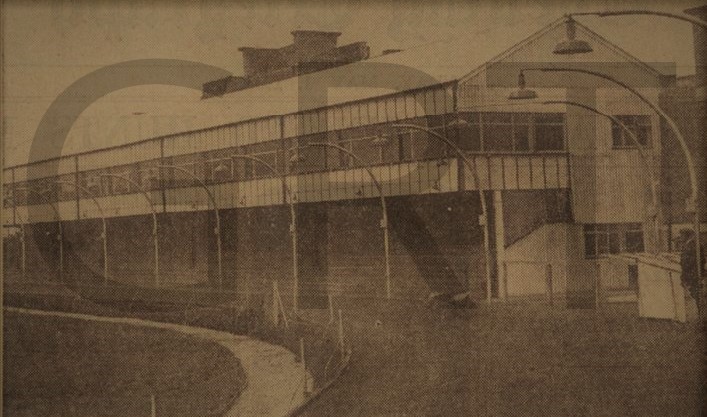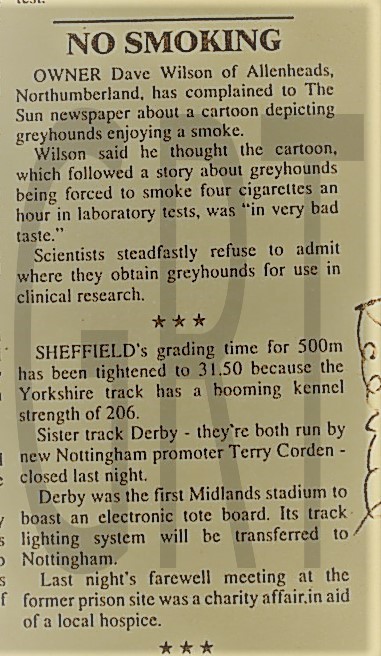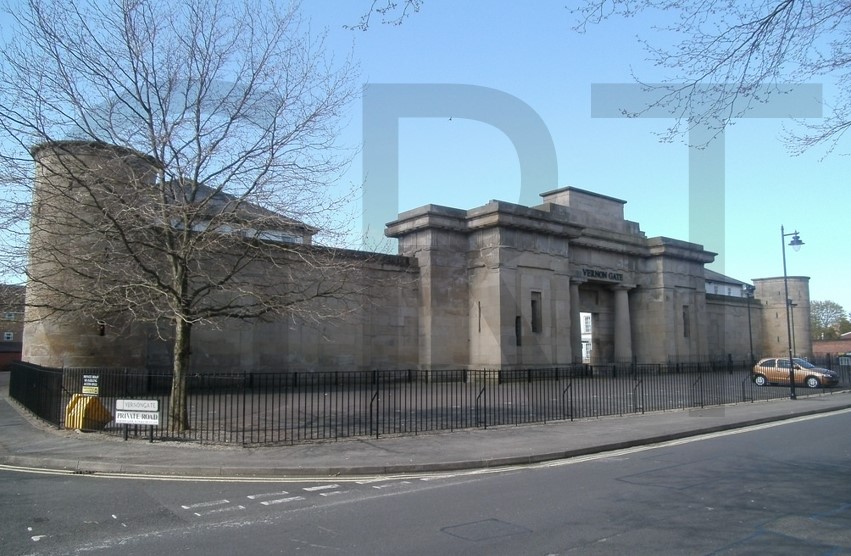Vernon Gate, Vernon Street, Derby, Derbyshire.
POSTCODE———————————-DE1 1UJ
LOCATED————————————About one mile north west of Derby city centre.
ORIGINAL SITE—————————–Built on the grounds of a derelict prison.
DATE CONSTRUCTED——————–1932
DATE VENUE OPENED——————-April 1933.
Meaning other sports may have taken place prior to the arrival of Greyhound Racing.
FIRST MEETING—————————-April 29th 1933 a meeting with 4 dog races only, the first being won by Tramore Lad over 260 yard trip.
Greyhound Racing only.
LICENSED OR INDEPENDENT———-NGRC.
All venues covered would have to be licensed with the government, licensed suggested in this section would refer to tracks operating under NGRC Rules.
INSIDE OR OUTSIDE HARE TYPE——-Inside Sumner.
Please note that the Electric Hare suggested is only a guidance and would have been in operation for a certain amount of time at this venue. Although it is not necessarily guaranteed that it was operational all the time, as other types of lure may have been used and updated as time progressed.
DISTANCES———————————–246, 420, 590 and 764 metres.
Please note that most racing venues distances had become varied throughout the years, the ones given above were at once point set and offers only a guidance to the track size.
CIRCUMFERENCE—————————344 metres.
Please note that alterations at most racing venues throughout its existence would see that the circumference of the track would vary, the one shown above offers only a guidance to the track size.
BIG RACE NAMES—————————The Derby Plate contested over 420 metres and the Derby Vase over the 590 metres. The great Scurlogue Champ made one appearance on the 16th of November 1985, setting a new track record of 49.04 secs over the 764 metre trip.
STADIUM SHARED WITH——————Nothing found.
LAST MEETING——————————-December 7th 1988.
Greyhound Racing only.
STADIUM CLOSURE DATE—————-December 1988.
Meaning other sports may have taken place after Greyhound Racing had ceased.
STADIUM DEMOLITION——————–Early 1990’s.
BUILT ON SITE——————————–A Business Centre and modern housing constructed in 1996 now occupies the site.
In some cases, structure’s that originally covered the venue after the stadium had been demolished, may have been themselves demolished too, so the one described is more likely to be the one which now presently covers the site.
EVIDENCE LEFT TODAY——————–The white stoned entrance of the prison and the stadium is clearly evident today on Vernon Street.
FURTHER COMMENTS———————Both the Derby and Preston tracks were owned by the same company.
Before that it was Derby’s Prison where the last public hanging in England was performed on April 11th 1862.












Derby Greyhound Stadium was situated one mile north west of Derby city centre, hemmed in amidst a densely populated area of the city. The venue also became known to its regulars as Vernon Gate, having been constructed on the demolished site of one of Her Majesty’s old prisons of the same name. The prison began its duties during 1827, and would eventually serve the country for the next 90 years or so, before it finally closed in 1919.
The following ten years would see it serve as a military prison before that too closed in 1929. The Vernon Gate prison can also be found in a number of Britain’s history books, with its claim to fame of being the first prison to organise a public hanging. It was on the 12th of April 1833, that 6,000 onlookers witnessed twenty-year-old John Leedham being hanged, his crime being for bestiality with a sheep. The last public hanging at the gaol was in April 1862, when Richard Thorley aged 35, was hung for cutting the throat of a young woman in February of that year. The last person to be executed on its premises was in 1907, when a 47-year-old man called William Slack, was hung for murdering his ex-partner with a hatchet.
After its closure in 1929, the prison lay unoccupied for a couple of years before being demolished in 1931. Not everything of the gaol was lost, as its main feature had been an impressive stone entrance, which fortunately survived the demolition, and would eventually serve as the entrance gates to the newly constructed greyhound stadium. Construction of the actual stadium began in 1932, with the whole project being funded by The Preston Greyhound Company, a company who had already promoted Greyhound Racing in their hometown twelve months previous.
By the time the Derby venue was ready to stage its inaugural meeting, it had cost an estimated £40,000 to construct, the cost also including a large cluster of racing greyhounds, which would soon be permanently kennelled in the grounds of the stadium. Derby’s first meeting came on the 29th of April 1933, with all races made up of just four greyhounds, this due to the lack of hounds available at the time, but a greyhound called Tramore Lad made a name for himself by winning the first ever event over 260 yards. But it did not take long before teething problems were overcome, and Greyhound Racing in Derby began to flourish.
Meetings were staged under NGRC rules, with the track offering as many, like most around that period, four meetings a week. The Derby venue became the first Midlands track to boast an electronic tote board, which came into operation during 1935. Its main classic events were The Derby Plate run over 420 metres, and also The Derby Vase, this event contested over the 590 metres trip. Regular distances were run over 246, 420, 590 and 764 metres, with the track having a circumference of 344 metres, and seeing the hounds chase an inside Sumner type hare. Vernon Gate may not have been the Ascot of the greyhound tracks, but did attract big names in the sport, such as the famous Scurlogue Champ, a greyhound that made a one-off appearance on the 16th of November 1985, by leaving his mark by breaking the track record over 764 metre trip.
Sadly, neither Derby nor Preston ever reached their Diamond Jubilee’s, as 1988 became the year the axe came down on both tracks, surprisingly enough still being run by the same Preston administration. Derby Greyhound Stadium staged its final meeting on the 7th of December 1988, a charity event set aside for the local hospice, with a greyhound called On Sunday winning the final event. Strangely enough, its sister track at Preston also closed just thirteen days later. The tracks lighting system was purchased almost immediately, and was transferred to Nottingham’s Colwick Park, leaving the rest of the stadium to just drift in to a derelict state over the following years.
The unoccupied stadium suffered from the disrespect of vandals and arsonists, just like most derelict sites did, right up until the day the bulldozers moved in during the early 1990’s. The site eventually became redeveloped in 1996, with new housing, along with a business centre, overwhelming the majority of the site.
As for today, luckily enough, one good feature remains, and that is the huge stone entrance that once served the gaol and the greyhound stadium, and has now become part of Derby’s heritage, similar to that of Manchester’s old White City Greyhound Stadium.
A programme, photograph or even memorabilia for this track is required for this page, if you can help please contact me.

Recent Comments